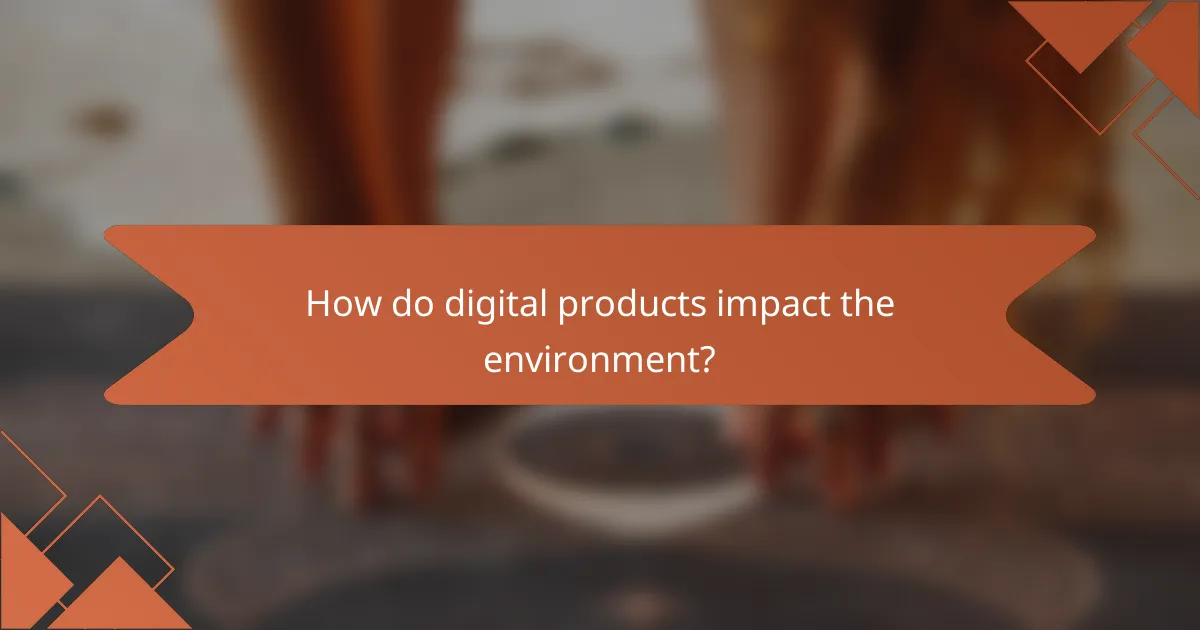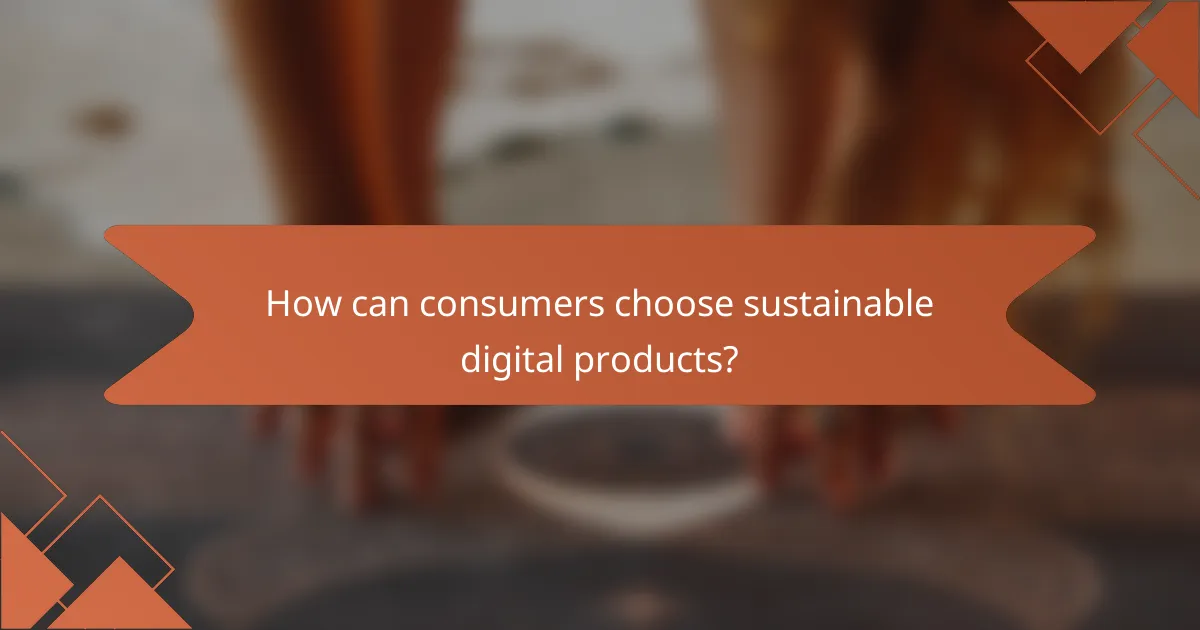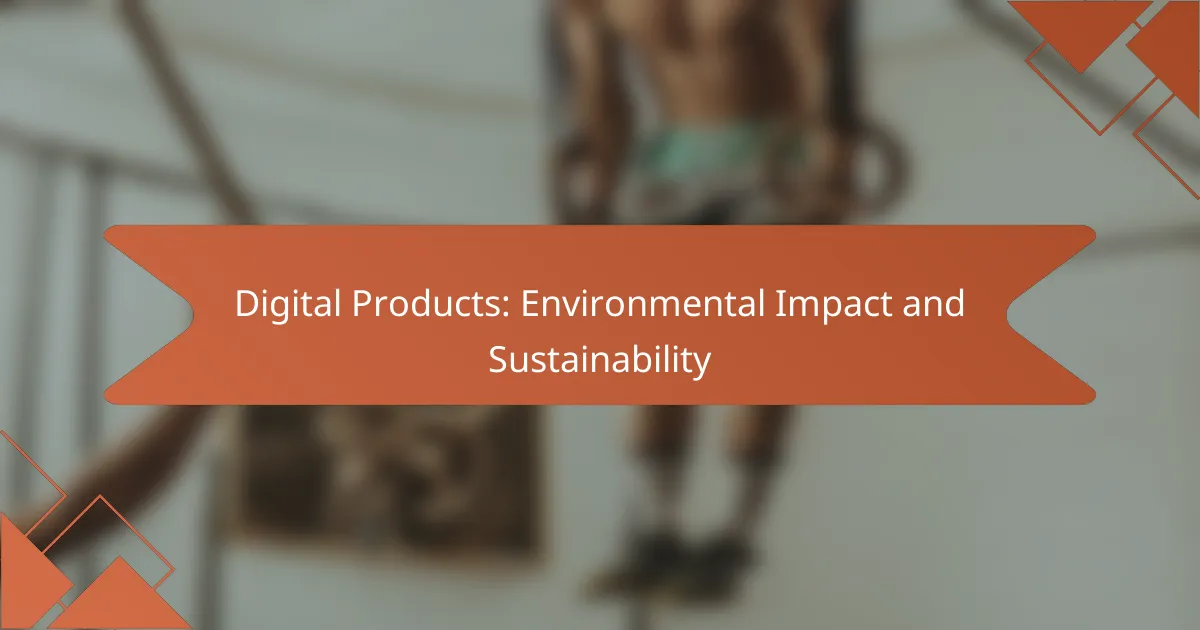The environmental impact of digital products is increasingly significant, driven by their carbon footprint, energy consumption, and the generation of electronic waste. To promote sustainability, companies can adopt practices such as utilizing renewable energy and implementing eco-friendly design principles. Consumers also play a crucial role by selecting energy-efficient products and supporting brands committed to sustainability, thereby reducing their overall environmental footprint.

How do digital products impact the environment?
Digital products have a significant environmental impact primarily through their carbon footprint, energy consumption, and the generation of electronic waste. Understanding these factors is essential for evaluating the sustainability of digital technologies.
Carbon footprint of digital products
The carbon footprint of digital products stems from the production, usage, and disposal phases of these technologies. Manufacturing processes often involve energy-intensive operations, contributing to greenhouse gas emissions.
For instance, the production of a single smartphone can generate several hundred kilograms of CO2, depending on the materials and energy sources used. Reducing this footprint involves choosing products made from sustainable materials and supporting companies with eco-friendly practices.
Energy consumption in data centers
Data centers, which host the servers for digital products, consume vast amounts of energy, primarily for cooling and operation. Estimates suggest that data centers account for a significant percentage of global electricity use, often relying on non-renewable energy sources.
To mitigate energy consumption, companies are increasingly adopting energy-efficient technologies and renewable energy sources. Users can also contribute by utilizing cloud services that prioritize sustainability and by minimizing unnecessary data storage.
Electronic waste from digital devices
Electronic waste (e-waste) is a growing concern as digital devices reach the end of their life cycle. Improper disposal of e-waste can lead to environmental pollution and health hazards due to toxic materials found in many electronic components.
To combat e-waste, consumers should recycle old devices through certified e-waste recycling programs. Many manufacturers offer take-back schemes, allowing users to return their outdated products for proper recycling and reuse, thereby reducing the overall environmental impact.

What sustainable practices can digital product companies adopt?
Digital product companies can adopt various sustainable practices to minimize their environmental impact. Key strategies include utilizing renewable energy sources, implementing eco-friendly design principles, and reducing server energy consumption.
Utilizing renewable energy sources
Switching to renewable energy sources, such as solar or wind power, significantly reduces a company’s carbon footprint. Many tech companies are now committing to 100% renewable energy for their operations, which can also lead to cost savings over time.
To implement this, businesses can partner with renewable energy providers or invest in on-site generation systems. Additionally, certifications like Green-e can help ensure that the energy sourced is genuinely renewable.
Implementing eco-friendly design principles
Eco-friendly design principles focus on creating digital products that are efficient and sustainable throughout their lifecycle. This includes optimizing software to reduce resource consumption and designing for longevity to minimize the need for frequent updates or replacements.
Companies can adopt practices such as using energy-efficient coding techniques and prioritizing minimalistic design. Tools like eco-design checklists can help teams evaluate their projects against sustainability criteria.
Reducing server energy consumption
Reducing server energy consumption is crucial for digital product companies, as data centers are significant energy consumers. Strategies include optimizing server utilization, using energy-efficient hardware, and employing virtualization technologies to maximize resource use.
Regular audits can help identify areas for improvement, and adopting practices like server consolidation can lead to substantial energy savings. Companies should also consider the geographical location of their data centers to take advantage of cooler climates, which can reduce cooling costs.

How can consumers choose sustainable digital products?
Consumers can choose sustainable digital products by evaluating their energy efficiency, supporting eco-conscious brands, and understanding the lifecycle impacts of these products. Making informed choices helps reduce environmental footprints and promotes sustainability in the digital marketplace.
Evaluating energy efficiency ratings
Energy efficiency ratings indicate how much energy a digital product consumes during operation. Look for products that meet or exceed established standards, such as ENERGY STAR certifications, which can signify lower energy usage and reduced environmental impact.
When comparing devices, consider their annual energy consumption in kilowatt-hours (kWh). Products that consume significantly less energy can lead to savings on electricity bills and contribute to a smaller carbon footprint over time.
Supporting eco-conscious brands
Choosing to purchase from brands that prioritize sustainability can have a positive impact on the environment. Look for companies that use renewable materials, implement recycling programs, and have transparent supply chains.
Research brands’ sustainability initiatives and certifications, such as B Corp or Fair Trade, to ensure they align with eco-friendly practices. Supporting these brands encourages more companies to adopt sustainable methods.
Understanding product lifecycle impacts
The lifecycle of a digital product includes its production, usage, and disposal phases. Each stage has environmental implications, from resource extraction to energy consumption and waste generation.
Consider the durability and repairability of products, as longer-lasting devices reduce the frequency of replacements. Additionally, check if the manufacturer offers recycling options to minimize waste at the end of the product’s life.

What are the regulatory frameworks for sustainability in digital products?
Regulatory frameworks for sustainability in digital products aim to set standards and guidelines that promote environmentally friendly practices. These frameworks often focus on data privacy, consumer protection, and the overall impact of digital services on society and the environment.
EU Digital Services Act
The EU Digital Services Act (DSA) establishes a comprehensive regulatory framework for digital services within the European Union. It aims to create a safer online environment by imposing obligations on digital platforms to manage content responsibly and protect user rights.
Key provisions include requirements for transparency, accountability, and the mitigation of harmful content. Companies must assess their environmental impact and take steps to minimize it, which can include adopting sustainable practices in data centers and reducing energy consumption.
California Consumer Privacy Act
The California Consumer Privacy Act (CCPA) focuses on consumer rights regarding personal data and privacy. While primarily a privacy regulation, it indirectly influences sustainability by encouraging companies to adopt more responsible data management practices.
Under the CCPA, consumers have the right to know what personal data is being collected and how it is used. This transparency can lead to more sustainable practices as companies strive to build trust with consumers and reduce their environmental footprint through efficient data handling and storage solutions.

How do digital products contribute to a circular economy?
Digital products play a significant role in a circular economy by minimizing waste and maximizing resource efficiency. They enable reuse, recycling, and sustainable practices that reduce environmental impact while promoting economic growth.
Promoting digital product recycling
Recycling digital products involves recovering materials from obsolete devices and repurposing them for new uses. This process not only conserves resources but also reduces the demand for raw materials, which can be environmentally harmful to extract.
Many manufacturers now offer take-back programs, allowing consumers to return old devices for recycling. This initiative helps ensure that valuable materials, such as metals and plastics, are properly processed and reused, contributing to a more sustainable lifecycle for digital products.
Encouraging software updates for longevity
Regular software updates are crucial for extending the lifespan of digital products. By keeping software current, users can enhance performance, fix security vulnerabilities, and ensure compatibility with new technologies, which reduces the need for frequent replacements.
Companies should prioritize providing updates for older devices, as this can significantly delay obsolescence. Consumers can also play a role by regularly checking for updates and avoiding the temptation to replace devices prematurely, thus supporting a more sustainable approach to technology use.

What are the future trends in sustainable digital products?
Future trends in sustainable digital products focus on reducing environmental impact through energy-efficient technologies and responsible resource management. Innovations in software design, cloud computing, and digital services are increasingly prioritizing sustainability, aiming to minimize carbon footprints and promote eco-friendly practices.
Energy-efficient technologies
Energy-efficient technologies are becoming essential in the development of sustainable digital products. This includes optimizing software to consume less power and utilizing hardware that meets high energy efficiency standards. For example, devices that comply with Energy Star ratings can significantly reduce energy consumption compared to older models.
Additionally, cloud computing offers a more sustainable alternative to traditional data storage. By consolidating resources in data centers that use renewable energy, companies can lower their overall energy usage and carbon emissions.
Responsible resource management
Responsible resource management involves using materials and processes that minimize environmental harm. Digital product developers are increasingly focusing on sustainable sourcing of materials and reducing waste throughout the product lifecycle. This can include using recycled materials in hardware production or ensuring that software updates extend the lifespan of existing devices.
Companies are also adopting circular economy principles, which emphasize reusing and recycling products rather than discarding them. This approach not only conserves resources but also reduces the demand for new materials, leading to a smaller environmental footprint.
Regulatory compliance and standards
Regulatory compliance is becoming a critical aspect of developing sustainable digital products. Governments and organizations are implementing stricter regulations regarding electronic waste, energy consumption, and carbon emissions. For instance, the European Union’s Waste Electrical and Electronic Equipment (WEEE) Directive mandates proper disposal and recycling of electronic products.
Staying informed about these regulations is essential for companies aiming to create sustainable products. Adhering to recognized standards, such as ISO 14001 for environmental management, can enhance credibility and marketability while ensuring compliance with local laws.
